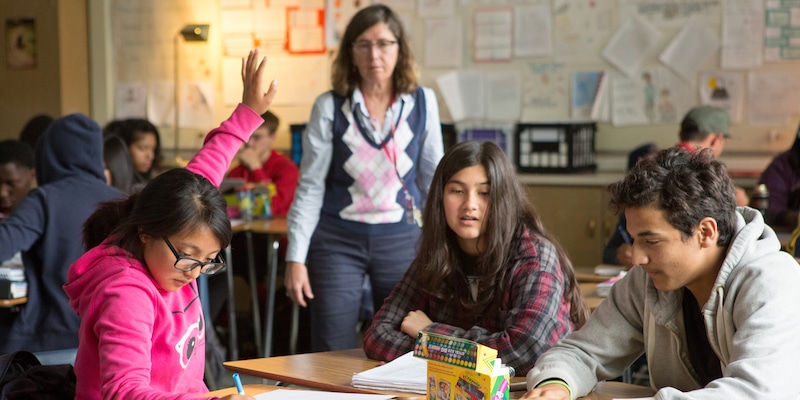Last December, Larry Cuban raised an interesting question on his blog: “Whatever happened to team teaching?” In his piece, Cuban wonders why team-teaching—a “best practice” promoted by national associations in the 1960s—largely disappeared by the mid-1970s. His post caught my attention because of its relevance to innovative staffing arrangements I studied last year. Many of the schools we visited for that project used some form of team teaching, and their teachers spoke glowingly about how much they valued learning from, and receiving support from, their colleagues. But these same teachers also admitted that working together had its challenges.
After reflecting on the benefits and challenges of team teaching in the schools we observed, I think Modularity Theory may explain why it has never become a widely-adopted practice.
What is Modularity Theory?
Modularity Theory explains key differences in how people, teams, or systems interact with one another. According to the theory, interactions—also referred to as interfaces—lie on a spectrum ranging between modular and interdependent.
Interactions are interdependent when there are no clear rules or structures defining how people should coordinate their work. Interdependence makes collaboration essential because people have to figure out how their individual efforts fit together. If they shortchange collaboration, their work is disjointed, and they have a hard time achieving shared goals.
In contrast, interactions are modular when rules and structures allow people to work at arm’s length. They don’t have to spend time collaborating because rules and structures pre-define how their work should come together. The advantage of modularity is efficiency: it reduces or eliminates the need to spend time coordinating. But modularity has a downside: pre-defined rules and structures aren’t good at doing anything other than what they were designed to do. When new opportunities or challenges arise, it’s hard to address them while relying on modular interactions.
Why schools place teachers in silos
As Cuban points out, proponents of team teaching have long seen it as “the solution to the organizational problem of stodgy, individualistic teaching in the age-graded school’s self-contained classrooms when collaboration was rare and isolation was the rule.” Yet proponents of team teaching often overlook the reasons why those “barriers” emerged in the first place.
Siloed teaching happens because of rules and structures designed to create modularity. Teaching is demanding work, and many teachers struggle to find time for all the responsibilities on their plates. But the demands on teachers’ time would be much worse without structures that reduce the need for coordination with things external to the teachers’ class. Course sequences, credit hours, class rosters, bell schedules, and rooms separated by cinderblock walls all create modular, predictable interactions with the world outside a class. In doing so, they reduce the coordination demands on teachers’ time.
Why team teaching doesn’t stick
Unfortunately, rules and structures that create modularity to save teachers time also leave teachers feeling isolated. By reducing the need for coordination, they deprive teachers of opportunities to learn from each other, help each other with challenges, and find collegial support. Hence the reason why team teaching keeps cropping up to address these challenges.
Yet team teaching doesn’t stick because its benefits come at a substantial cost: time. By moving away from modular interactions, team teaching requires teachers to spend more time coordinating their collective efforts. Thus, when teachers feel pinched for time, they often regress back to the modular structures of siloed teaching to make their workload more manageable.
3 ideas to make team teaching work
Is there a way to make team teaching sustainable? Here are a few possibilities:
1. Schedule more time for collaboration
The most straightforward way to make team teaching sustainable is to give teachers more time in their schedules for collaboration. Innovative approaches to master scheduling—such as those offered by Abl or Tegy—are one way to make more time for collaboration within existing teaching loads. But to substantially increase collaboration time often requires cutting back on teachers’ instructional duties. And cutting back instructional duties while still giving students their required instructional minutes requires either creative staffing and budgeting—as found in some of Opportunity Culture’s models—or additional funding to hire more teachers.
2. Make collaboration more efficient
To some degree, innovative collaboration tools can help reduce the time required for coordinating team teaching. For example, cloud-based tools like Google Docs and Google Slides allow teachers to work both simultaneously and asynchronously on a lesson plan or presentation. Basic communication tools such as email can also help lower the burden of coordination. The time saved by these tools is marginal at best, but still worth considering.
3. Make team teaching arrangements more modular
The more that team teaching arrangements have clearly defined roles, responsibilities, and norms, the less time team teachers need to spend coordinating their work. In Cuban’s post, he provides a link to six approaches to co-teaching. Interestingly, all of the approaches except for “team teaching” assign distinct roles and responsibilities for each teacher—effectively defining modular interactions for the co-teaching arrangement.
One of the most interesting innovations I’ve seen for modularizing the team-teaching interactions is New Classrooms. Their back-end algorithms do the complex work of matching students’ daily learning needs with lesson resources and teacher schedules to coordinate multiple adults teaching in the same learning space. Yet they still find that teachers using their model need time set aside for collaboration.
In sum, team teaching involves tradeoffs. It can be a good way for teachers to learn from one another and support one another. But those benefits come at the cost of a prized resource: teachers’ time. Teachers are often dissatisfied with the siloed nature of traditional teaching. But for team teaching to be sustainable, schools need innovative approaches for addressing the time demands of collaboration.
Photo courtesy of Allison Shelley/The Verbatim Agency for American Education: Images of Teachers and Students in Action.


